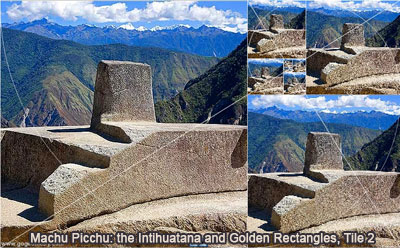Machu Picchu
Built in the 1460s and abandoned for three centuries after the Spanish conquest, Machu Picchu, or “Old Peak” in the Quechua language, was rediscovered by U.S. archeologist Hiram Bingham in 1911. Machu Picchu is wonderful and incomparable, not only for its unique architecture. The natural beauty is astounding.
Intihuatana
The Intihuatana stone is one of many ritual stones in South America. The Spanish did not find Machu Picchu so the Intihuatana Stone was not destroyed as many other ritual stones in Peru were. These stones are arranged to point directly at the sun during the winter solstice. Intihuatana
also is called "The Hitching Point of the Sun" because it
was believed to hold the sun in its place along its annual
path in the sky. At midday on March 21 and September 21, the
equinoxes, the sun stands almost above the pillar - casting no
shadow at all.
Golden Rectangle
A golden rectangle
is a rectangle whose side lengths are in the golden ratio, one-to-phi, that is, approximately 1:1.618.
A distinctive feature of this shape is that when a square section is removed, the remainder is another golden rectangle, that is, with the same proportions as the first. Square removal can be repeated infinitely, which leads to an approximation of the golden
or Fibonacci spiral.
Fibonacci numbers
Fibonacci numbers
(0,1,1,2,3,5,8,13,21,34...) are a sequence of numbers named after Leonardo of Pisa, known as Fibonacci.
The first number of the sequence is 0, the second number is 1, and each subsequent number is equal to
the sum of the previous two numbers of the sequence itself.
Droste Effect
The Droste effect is a specific kind of recursive picture, one that in heraldry is termed mise en abyme. An image exhibiting the Droste effect depicts a smaller version of itself in a place where a similar picture would realistically be expected to appear. This smaller version then depicts an even smaller version of itself in the same place, and so on. Only in theory could this go on forever; practically, it continues only as long as the resolution of the picture allows, which is relatively short, since each iteration geometrically reduces the picture's size. It is a visual example of a strange loop, a self-referential system of instancing which is the cornerstone of fractal geometry.
Source:
Wikipedia,
Droste Effect.
